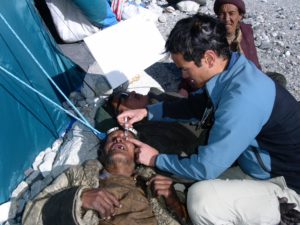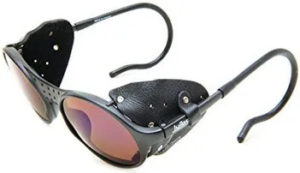Contents
Snow Blindness
Unlike the rest of the eye conditions, snow blindness is totally preventable and is also referred to as “Photokeratitis.” The temporary and painful loss of vision because of exposure to the sun’s UV rays is known as Snow blindness.
The word “Photokeratitis” is made by joining two words – “Photo meaning light and keratitis meaning inflammation of the cornea.” It is caused due to sunburned cornea.
How Can Someone Develop Snow Blindness?

Although the name of the condition is “Snow blindness”, it can also occur in the absence of snow. Snow is highly reflective of the sun’s ultraviolet rays. According to some studies, snow reflects back up to 80% of the UV rays that fall on it. Sun’s UV rays are strongest in high-altitude places. And mostly, mountain climbing, snowboarding, etc. takes place at high altitudes. Thus, the chances of developing snow blindness increases.
There are two more factors that increase the risk of this blindness – water and sunlight. Thus, when all these factors have been combined the risk of developing snow blindness can increase drastically.
As mentioned above, people can develop snow blindness without actually being in the snow. But, snow blindness can also be caused without sunlight too. Sometimes, Photokeratitis can occur because of the man-made source of ultraviolent rays such as the “Welder’s torch.”
Though this condition is commonly known as “Flash burn” of the cornea, the mechanism of action and symptoms are the same as for snow blindness. Without proper eye protection, sun lamps and tanning booths can also cause snow blindness.
Symptoms of Snow Blindness

The symptoms of snow blindness occur or worsen after a few hours of exposure to the UV rays. The symptoms of snow blindness are like the delayed symptoms of sunburn. Most common snow blindness symptoms include:
Pain In The Eyes/Head
Due to total exposure of the eye to the UV rays of the sun, there can be severe eye pain in the eye. The pain and discomfort can go from mild to severe. The pain bothers the most when blinking because the eyelid is rubbed across the cornea while blinking. Being outside in the sun and snow can cause a severe headache. Consumption of appropriate pain killer with proper rest can help to reduce the pain.
Burning Sensation In The Eyes
A sensation of burning in the eye can have several possible reasons when caused due to snow blindness. Mostly, the burning sensation occurs with itchiness, eye pain, watery eyes, and discharge from the eyes. The burning sensation is caused by painful inflammation in the cornea. When the eye is exposed to ultraviolet rays, a flash burn is caused in the outer layer of the eyes.
Redness In The Eyes
Redness in the eye is a condition where the sclera of the eye becomes reddened or bloodshot. Red eyes can be associated with other discomforts in the eye including “Irritation, Itchiness, Dryness, etc.” Eyes become red due to the dilation of tiny blood vessels which are located between the sclera and the conjunctiva of the eye. These tiny blood vessels become swollen due to overexposure of the sclera to the ultraviolet rays.
A Persistent Feeling of Foreign Body In The Eyes
Dryness in the eyes along with inflammation in the eyelids can sometimes make the person feel that there is something in the eyes even though there is nothing. Without any protective sunglasses or snow goggles, there can be an inversion of the foreign body in the eye and cause discomfort in the eyes.
High Sensitivity To Light
Sources that cause the eyes to squint or cause any discomfort due to high sources of light such as “Sunlight, Fluorescent light and Incandescent light” make the eyes highly sensitive towards the light. The reflection of UV rays in the eyes caused by the snow, can make the eye vision weak and cause glare around any light.
Watery Eyes
Overexposure to ultraviolet rays in highly reflective snow can block the ducts or narrow a few ducts in the eyes. This can lead to watery eyes. The highly reflective snow causes snow blindness which can narrow the duct, resulting in swelling.
Swelling In The Eyelids or The Eyes
Due to inflammation or excess produce of the fluid, Edema, there can be swelling in the eyelids. If the swelling doesn’t reduce within two days, it is advisable to visit an ophthalmologist to check whether it is a serious problem or not.
Blurry Vision
The eyes can become blur due to a problem in the components of eyes such as “Cornea, Retina, or Optic Nerve.” Due to the exposure to ultraviolet rays, a sudden blurriness is caused in the eyes.
Vision loss caused due to snow blindness is temporary and mostly resolves in 24 to 48 hours. Although no actual blindness is caused by snow blindness still, it can severely impair the vision of the eyes. There can also be an effect on color vision when someone is suffering from snow blindness.
Risks of Snow Blindness
Snow blindness usually goes away on its own within a week, like a sunburn. You should avoid driving or operating heavy machinery if you’re experiencing any symptoms of snow blindness. Its impact on your vision can make those activities dangerous.
Too much exposure time in the sun without eye protection can cause more serious conditions, like:
- Eye cancer
- Cataracts
- Growths on the eyelid
- Vision loss and farsightedness
How To Avoid Snow Blindness

For total avoidance, wear sunglasses that block 100 percent of the sun’s UV rays. People can also use sun-sensitive “Photochromic lenses” which are more convenient to avoid getting snow blindness. The ultraviolet radiation can easily penetrate the clouds, so there is always a risk of developing snow blindness even if it is a cloudy or overcast day.
Invest in quality sunglasses, whenever planning to go outdoors for skiing, skateboarding, water sports, etc. Buy sunglasses that feature a wrap-style frame that can help you to protect your eyes from direct as well as indirect sunlight.
For optimum protection, look for sunglasses or snow goggles that have a side shield or soft rubber flange that can completely clog the sunlight from entering the eyes from all the sides i.e. “Side, front, above and below.”
In case someone is unsure whether their sunglasses or snow goggles will block 100 percent UV rays or not, they can visit their ophthalmologist and can consult with them.
Treatment of Snow Blindness
- Most of the symptoms of snow blindness typically resolve in a day or two without any involvement in medical treatment.
- In case someone is wearing contact lenses, they should quickly refrain from wearing contact lenses. Until the time their eyes feel normal and their vision is back.
- To protect yourself from the pain and discomfort of snow blindness, either try to remain indoors or wear sunglasses. Whenever hanging out in the snow, keep your eyes well moistened with artificial tears. For mild dry eyes, choose preservative-free formulations.
- Use pain relievers in case the pain and discomfort in the eyes are unbearable. Still, one should be very careful while consuming snow blindness pain relief pills and should try not to overdo it. People suffering from snow blindness should be sure that they use only those pain relievers of which they are sure won’t cause any allergic reaction or complication to them.
- To provide comfort to the eyes, one can place a cool washed cloth over the eyelids.
- People who are suffering from this condition are advised not to rub their eyes for at least 24 hours. If the symptoms still exist after two days or they get worse, consult an ophthalmologist immediately.
- Use eye drops that can protect your eyes from dryness caused by sunlight. You can get these lubricating eye drops also known as artificial tears anywhere.
- Talk to an eye doctor, if your symptoms are getting worse.
The best way to treat your eyes is to visit your eye care professional and get your eyes checked regularly. He will be able to assess the best method of treatment for your eye ailment. Visit our website Eyemantra. To book an appointment call +91-9711115191. Or mail us at [email protected].
Our other services include Retina Surgery, Specs Removal, Cataract Surgery, and many more.



